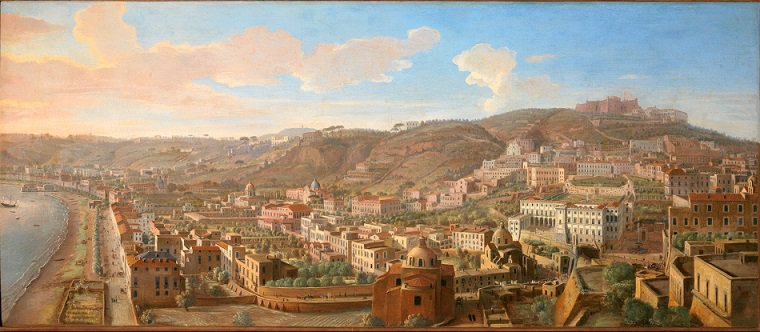During Mozart's lifetime, royal seat of the Kingdom of Naples. Formerly under Habsburg domain, Charles, Duke of Parma, took the Sicilian crown in 1734; when he became Carlos III of Spain in 1759 he installed his brother, Philip, as Ferdinand III of Sicily and Ferdinand IV of Naples, which remained under Bourbon control until 1860. During this time the city witnessed considerable new construction and restoration, including the building or renovation of the Teatro San Carlo, the Palazzo Reale, the Reggia di Capodimonte, the Villa di Portici, the royal palace at Caserta, the Piazza Mercato and the Cimitero di Poggioreale. It was also a prominent stopping place on the Grand Tour, in part for its proximity to Vesuvius and the recently-discovered towns of Pompeii and Herculaneum.

Gaspar van Wittel, Veduta di napoli con il borgo di chiaia da pizzofalcone, c1701 (Palazzo Zevallos Stigliano)
Musical life in Naples about 1770 was dominated by opera - both at the royal Teatro S Carlo, opened in 1737, and at opera houses run by private impresarios, including the Teatro Nuovo and the Teatro dei Fiorentini – and by sacred music, practiced at local churches and the Oratorio dei Girolamini. Instrumental music was less important, except in private settings, while Naples famous conservatories, including the Conservatorio di S Onofrio and the Conservatorio di S Maria della Pietà dei Turchini, had a European-wide reputation for music education. When the English composer and music historian Charles Burney visited Naples in 1770, he wrote (The Present State of Music in France and Italy, [second edition: London, 1773], 303-304):
- There are three Conservatorios in this city, for the education of boys who are intended for the profession of music, of the same kind with those of Venice, for girls. As the scholars in the Venetian Conservatorios have been justly celebrated for their taste and neatness of execution, so those of Naples have long enjoyed the reputation of being the first contrapuntists, or composers, in Europe.
- Mozart Relevance
-
Mozart and his father arrived in Naples on 14 May 1770. Their way was paved by Mathieu-Dominique Saint-Odîle, the Tuscan ambassador at Rome, who on 21 April had written a letter recommending the Mozarts to Giuseppe Bonechi, the Tuscan ambassador to Naples. Their activities during their near four-week stay in Naples are not well documented. They were received on 18 May by Bernardo Tanucci, Neapolitan minister of foreign affairs, and William Hamilton, and by Tanucci again on 20 May. They attended the opera on 21 May - Carlo Franchi’s La pastorella incognita at the Teatro dei Fiorentini – and on 27 May a rehearsal of Niccolo Jomelli’s Armida at the Teatro S Carlo. On 28 May they gave a concert at the home of Prince Kaunitz. In early June they toured the local sites and on 7 June departed for their return to Rome. A painting by Pietro Fabris, depicting a domestic music-making scene, may picture Mozart and his father performing.
- Category/Role
- City
- Date (Mozart)
- 1770-05-14 - 1770-06-25
- Location (Mozart)
- Naples
- Bibliographic Reference
- Basso 2006, 417-423; Cooley and Cooley, Pompeii and Herculaneum: A Sourcebook; Sigurdsson, 'The Eruption of Vesuvius in AD 79'
Pages referencing Naples:
The Mozarts as Collectors of Souvenirs
Surviving Souvenirs 1: Engravings of London purchased by, or given to, the Mozarts, 1764-5